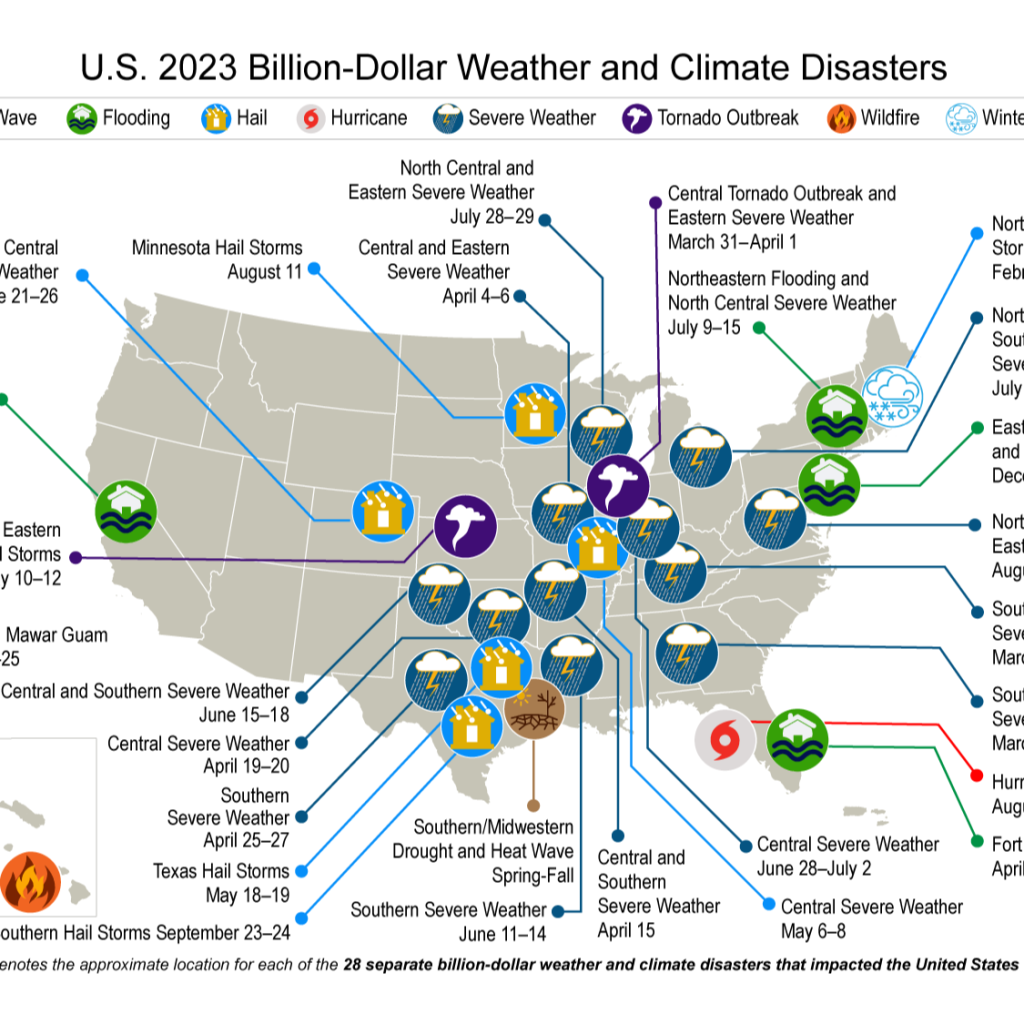Record number of billion-dollar disasters in U.S.

NOAA – An unprecedented number of billion-dollar disasters — 28 in total — struck the United States in 2023, as the remarkably warm year wrapped up with a record-warm December. This surpassed 2020 which had 22 events.
“For millions of Americans impacted by a seemingly endless onslaught of weather and climate disasters, 2023 has hit a new record for many extremes,” National Oceanic and Atmospheric Administration (NOAA) Chief Scientist Sarah Kapnick said. “Record warm U.S. temperatures in December, a record-setting number of U.S. billion-dollar disasters in 2023 and potentially the warmest year on record for the planet are just the latest examples of the extremes we now face that will continue to worsen due to climate change.”
The average annual temperature across the contiguous U.S. was 12.4 degrees Celsius — 1.3 degrees above the 20th-century average — ranking as the nation’s fifth-warmest year in NOAA’s 129-year climate record.
The year ended on a record-warm note as well. December 2023 ranked as the nation’s warmest December with an average temperature of 4.4 C, being four degrees above normal and besting the previously record-warmest December of 2021.
Louisiana, Massachusetts, Mississippi, New Hampshire and Texas saw their warmest year on record, while Connecticut, Florida, Maine, Maryland, Vermont and Virginia saw their second-warmest. An additional 24 states experienced a top-10 warmest year on record.
Annual precipitation across the contiguous U.S. totaled 748.3 millimetres (12.2 mm below average), which placed 2023 in the driest third of the climate record. Louisiana had its eighth-driest year on record, while Maine ranked fifth-wettest and Vermont and Connecticut both ranked sixth-wettest. Massachusetts, New Hampshire and Rhode Island all saw a top-10 wettest year.
Drought reached a peak coverage of 46.3 per cent of the contiguous U.S. at the beginning of 2023. Drought coverage across the nation shrank as atmospheric rivers and the summer monsoon brought above-normal precipitation to much of the western U.S., recharging some of the major reservoirs that dropped to their lowest levels in 2022. Drought reduced to a minimum extent of 19 per cent on May 30 — the smallest footprint for the contiguous U.S. since mid-2020.
“Record heat waves, drought, wildfires and floods are a sobering reminder of the consequences of the long-term warming trend we’re seeing across our country. These findings underscore the need for the data products and services provided by NOAA, like this annual report, to help create a more informed and climate-ready nation,” said NOAA National Centers For Environmental Information (NCEI) Director Deke Arndt.
The 28 events in 2023 comprised of 17 severe weather/hail events, four flooding events, two tropical cyclones, two tornado outbreaks, one winter storm/cold wave event, one wildfire event, one drought and heat wave event.
The total cost for these disasters was US$92.9 billion, but that may rise by several billion dollars when the costs of the Dec. 16 to 18 East Coast storm and flooding event are fully accounted for.
The most costly events in 2023 were the Southern/Midwestern drought and heat wave event at US$14.5 billion, and the Southern/Eastern severe weather event in early March, at US$6.0 billion.
The tornado count for 2023 was above average with 1,197 tornadoes reported, and an additional 97 preliminary tornadoes still under verification for the Oct. 1 to Dec. 31 period.
The number of wildfires in 2023 was close to average, with more than 55,500 wildfires reported over the year. The total acres burned from these wildfires, at 2.6 million acres, were well below the ten-year average of 7.1 million. In Alaska, nearly 300,000 acres burned during the 2023 fire season — less than half of the state’s seasonal average.


